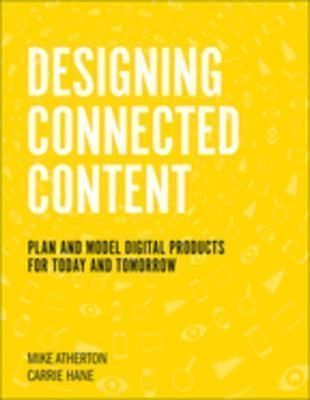
Designing Connected Content Plan and Model Digital Products for Today and Tomorrow
Reviews
It's a good book! Certainly an important framework for how to approach digital content, and it's a fairly digestible primer on some basic principles of database architecture specifically for the content designer and strategist. The idea of domain modeling is still a little opaque to me, hence the 3.5 star rating, but that may be more on me than on the book itself. Overall, would recommend if you are interested in future-proofing your content.
Highlights
Navigation shows your visitor how you think the subject domain is structured. It exposes your point of view.
Pg 186
The domain model maps your subject, not your website.
Domain research has a different focus than the UX research you may have encountered before. A good UX researcher attempts to understand user needs and clarify business requirements. [...] Domain research lays the groundwork for content structure. Your content implicitly or explicitly supports the concepts and relationships inherent in a topic
Pg64
Structured content is a lens into content strategy. Applying structure helps you get the right information to the right people at the right time without re-creating it time and again. This is the basis of content strategy, which advocates a content-first approach to projects. Not just writing the right content, but creating it the right way to be useful and usable.
Pg42
A domain model can help people get up to speed more quickly. Other teams can spend time coming to a shared understanding more quickly.
Pg29
Before creating something new, look at what is already in your inventory and pull it together in a new way. Think of yourself as a curator. Don't re-create things that already exist. When you break content into its smallest pieces, you can mix and match it in many ways much like an art museum. One year it has an exhibit of paintings by 19th-century French artists. Another year it has one of impressionists. Each one uses a subset of Claude Monet paintings, perhaps with different exhibit cards highlighting different qualities of the paintings.
Pg 20
When you separate content and structure from presentation, you're in great shape to design interface representations for any new device that comes along. And when that content is described with metadata, right down to the last attribute, then every new device [...] Can offera completely tailored experience.
Pg11
BECOMING FUTURE FRIENDLY
Not every benefit of adopting structured content will be felt right away. In the short term, you'l build an eficient, richly linked ecosystem that helps users find what they're looking for and helps your content creators focus on what they do best. You'll be shaping your content into small, sharable, reusable pieces to get the most use out of them. You'll have a clear strategy for which Content is most useful to invest in.
Pg11
People don't care about the containers; they care about the things they contain.
Pg7
Think of structured content as the design behind the design.
Designing from the content out, rather than the interface in, helps ensure that the visual presentation shows off the content at its best.
But design doesn't stop at the surface. User interfaces connect people to the business and, more immediately, to the business's content. Getting the content structure right is design. Designing the content is design. After all, the content is the whole damn point. It's why people are coming to your product in the first place. But if you start design with interface wireframes, a lot of things get lumped together. Decisions about structure, layout, hierarchy, navigation, and even editorial priority can rest on the scholders of an interface designer. By focusing first on structure, then on content design, and finally on interfaces, you can separate these concerns.
P.10
We believe you should design your content structure around real-world things. When people read a web page or watch a video or browse a photo gallery, what's interesting to them isn't that they're looking at a document, a photo, or a moving image. They're far more interested in what it's about. Inherent to any content you create are one or more specific examples of concepts. [...] People don't care about the containers; they care about the things they contain.